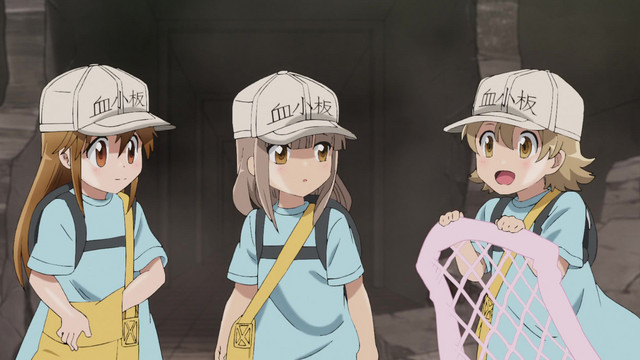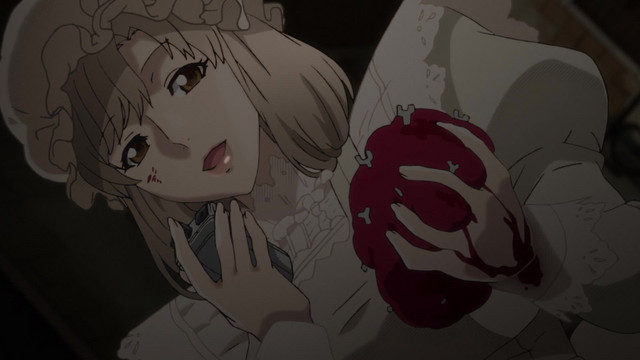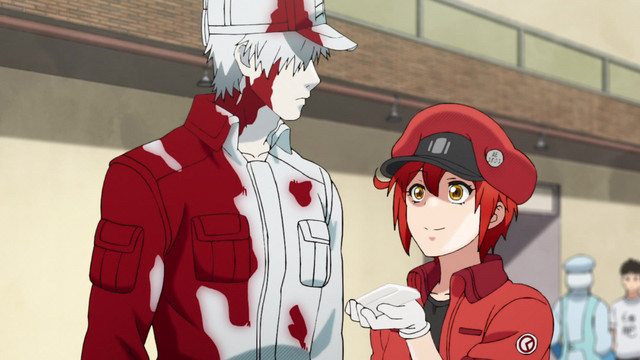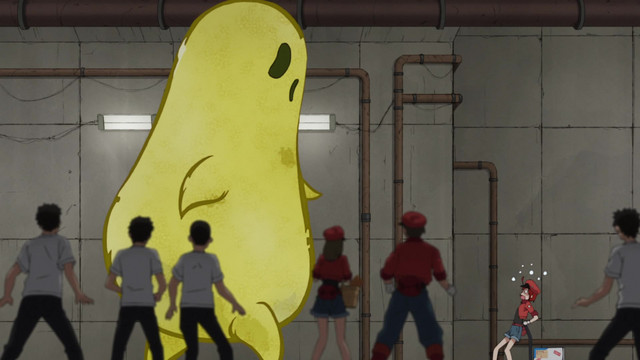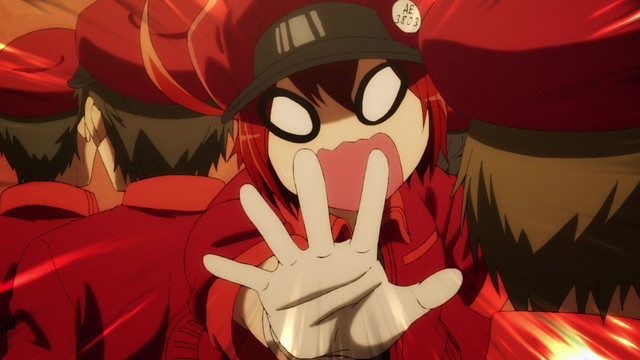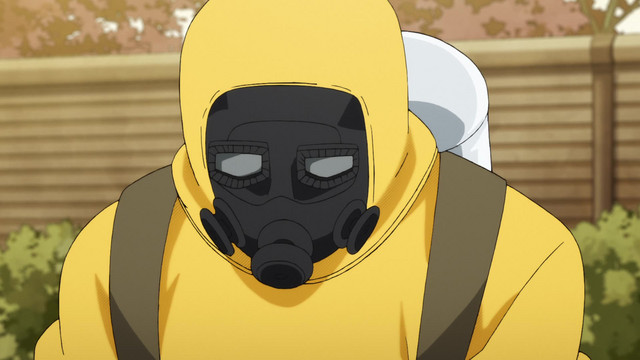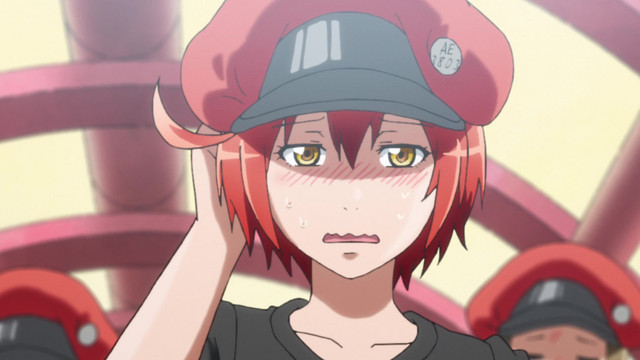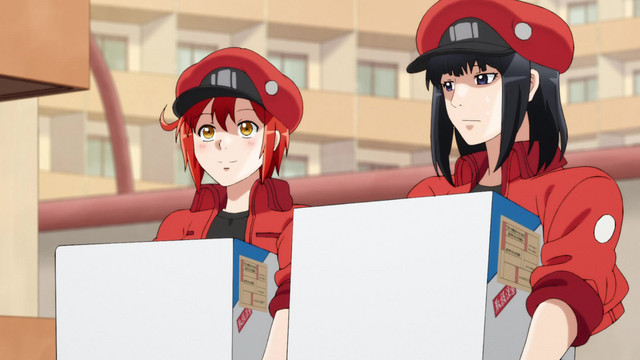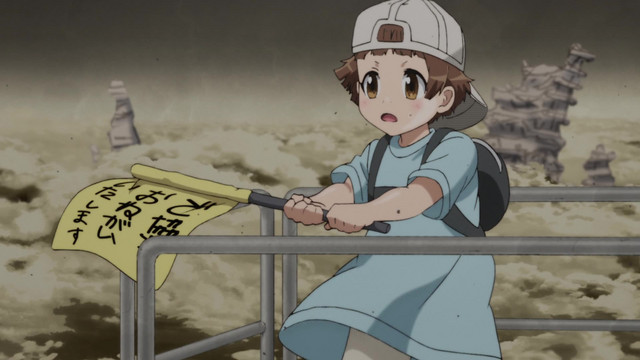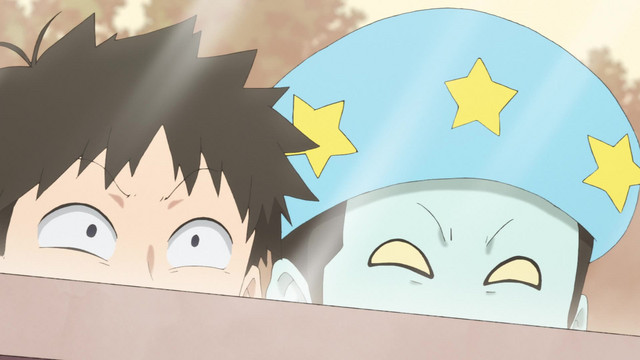HATARAKU SAIBOU
STATUS
COMPLETE
EPISODES
13
RELEASE
September 30, 2018
LENGTH
24 min
DESCRIPTION
The average human body contains about 60 trillion cells, and each of them has work to do! But when you get injured, viruses or bacteria invade, or when an allergic reaction flares up, everyone from the silent but deadly white blood cells to the brainy neurons has to work together to get through the crisis!
(Source: Kodansha Comics USA)
CAST

Hakkekkyuu U-1146

Tomoaki Maeno

Sekkekkyuu AE3803

Kana Hanazawa

Narrator

Mamiko Noto

Kesshouban

Maria Naganawa

Macrophage

Kikuko Inoue

Gan Saibou

Akira Ishida

Killer T Saibou

Daisuke Ono

Jujousaibou

Nobuhiko Okamoto

Natural Killer Saibou

Toa Yukinari

Kousankyuu

Mao Ichimichi

B Saibou

Shouya Chiba

Hakkekkyuu U-4989

Kentarou Kumagai

Helper T Saibou

Takahiro Sakurai

Sekkekkyuu AA5100

Aya Endou

Seigyosei T Saibou

Saori Hayami

Kioku Saibou

Yuuichi Nakamura

Kouenkikyuu

Tomokazu Sugita

Sekkekkyuu NT4201

Yui Ishikawa

Mast Saibou

Ayako Kawasumi

Naive T Saibou

Kenji Nomura

Haien Kyuukin

Hiroyuki Yoshino

Memory T Saibou

Ryouta Takeuchi

Oshokubudokyuukin

Mai Nakahara
EPISODES
Dubbed
RELATED TO HATARAKU SAIBOU
REVIEWS

Daemonplay
83/100A cool representation of interesting medical conceptsContinue on AniListAt the beginnig I was rather hesitant to watch this particular show. Honestly when I heard the concept of personified cells/microorganisms for the first time I was not surprised but I wasn't thrilled either. But my curiosity got the better of me in the end and here I am thoroughly surprised.
But let's start with the usual. Animation and art. I didn't expect anything fancy (and honestly this is not the type of show for that) so I was indeed quite pleased. Even though the animation was a bit sluggish at times (especially in fight scenes) I definitely wasn't disappoined. Now the art definitely captured the purpose of each cell/organism rather well in my opinion. I especially liked the uniform design and the expressiveness of the eyes (most noticeable in the case of white blood cells). The designs also seemed quite unique for the most part (safe for the cells in administrative positions like the Helper-T-Cell but honestly how creative can you actually be in that case?). Fine touches like the ahoge representing sickle cells (at least that's the theory) in red blood cell's case didn't go unnoticed and are much appreciated.
Now for the soundtrack. 41 (I believe) tracks overall and most of them quite atmospheric while not unnecessarily portruding. I personally enjoyed it even though I have to admit that no theme in particular really stuck with me safe for the opening (which I really liked from a musical point of view) and the "introduction theme" [meaning the soundtrack that plays in almost every episode (except in the second episodes of the two-parters) in the beginning while we get an overview of the world].
The story is handled in an episodic kind of way. Each episode brings with it new challenges to the body and therefore the cells. Be it cancer, allergies or dehydration. Something is always going on and the show as a whole is astoundingly accurate in its portrayal of these situations (except a few artistic liberties here and there). I was honestly surprised at the accuracy and I strongly believe that for some people such a portrayal of the aforementioned issues is easier to comprehend than strictly medical terms and depictions. In this sense the show fulfills an educational purpose I was quite happy to see.
Now the characters were quite cool to see. A lot of emphasis was put on nonstop-work and every cell being an important and indispensable piece of a larger machine which resulted in most problems that arise being of work related nature. Every character had his or her quirk which is tied to their function in the body and while there are billions of cells of each type our two "main" characters still seemed to have a personality of their own. Overall I really enjoyed the character depiction and growth throughout the show.
There is one complaint I have though. It's not massive by a long shot but definitely worth mentioning. If you are watching a few episodes back to back it can definitely be rather annoying to hear the description and functions of almost every cell in almost every episode. It probably is less of a problem if you watch the show weekly or aren't that bothered by repetition.
In the end I can't really recommend this show enough. At least if you have even the slightest interest in finding out what happens to your body in a few select situations it's definitely worth a shot. Scientifically mostly accurate, humorous characters and a nice underlying soundtrack. A very good show indeed.
And of course let us not forget the innocent sweetness of Platelet-chan.

(All rights to this picture belong to the artist)

super5aj123
80/100Cells At Work is both an educational, and entertaining show.Continue on AniListStory Summary Cells At Work! is an episodic series, with little overarching plot. (Not including multi-part episodes). It follows the two main characters Red Blood Cell AE3803, and White Blood Cell U-1146 along with various side characters such as the T-Cells, Macrophage, and Platelets, showing their involvement in various incidents in the human body, ranging from simple scrapes, to cancer.Characters The main two characters in this show are Red Blood Cell AE3808, and White Blood Cell U-1146, however for the sake of simplicity, I will just be referring to them as Red and White Blood Cell respectively. Red Blood Cell is played as a clumsy cell who is bad with directions. She regularly needs help from other cells to find where she is going, however despite this fact, she is heavily determined and always delivers her Oxygen. The other main character is White Blood Cell, who is shown to be cold and ruthless at first, but after the first episode or so, starts to warm up to Red Blood Cell, although he still keeps his ruthlessness for dealing with his enemies, the germ cells. Speaking of germ cells, they are usually the villains in each episode, usually having dangerous looking designs, although they are all one-off characters. There are other Red and White Blood Cells that we see, however they never really get fleshed out. There are also different varieties of White Blood Cells that we see throughout the series, such as the Killer, Naive, and Helper T Cells. Their job is to destroy anything that the standard White Blood Cells cannot, and they are characterized quite well, just like the main characters, and along with the Platelets and Macrophages, are some of the few recurring characters.Animation and Voice Acting Both animation and voice acting quality are very good with no noticeable drops in quality. Animation is sometimes used for visual gags, but the drop in quality for these gags is done well, and never takes you out of the moment.Comedy The comedy is done very well in the series. Along with the before mentioned visual gags, they also use recurring jokes, and while I won’t spoil any jokes, recurring or not here, I will say that they are done in a way that you recognise that it’s a recurring joke, without rolling your eyes due to bad attempts to shove jokes into serious scenes.TLDR In Short, Cells At Work is both an educational, and entertaining show, and well deserving of the 8/10 I have given it. [It also has a sequel set for Winter 2021](https://anilist.co/anime/117533/Hataraku-Saibou-BLACK/), as well as an OVA, with both available on AnimeLab, Crunchyroll, Funimation, Netflix, and VRV. 
Guiqml
81/100Um anime bem educativo e divertido, com bons personagens, mas que não é perfeito, mesmo assim é tranquiloContinue on AniListEu vou tentar ser o mais breve e objetivo possível, mas vou falar sobre tudo. PONTOS POSITIVOS - Roteiro bem estruturado em cada episódio. - Personagens divertidos e dinâmicos. - Termos científicos bem explicados de forma que foi fácil de compreender o que era dito. - As plaquetas( fofas demais). - Animação consistente e sem nenhuma distorção. PONTOS NEGATIVOS - Pelo fato de ser um anime episódico, as vezes falta um pouco de continuidade entre um episodio e outro. - Alguns personagens conforme o passar do anime acabam por ficar enjoativos. EXPLICAÇÃO DETALHADA O anime ele é bem tranquilo de se acompanhar sendo um bom anime de temporada, que você vê para passar o tempo, com o diferencial deste ser um anime bem educativo onde você vê vários médicos fazendo reações aos episódios desse anime. Essas reações mostram como são precisas as informações contidas nesse anime( claro que ele não substitui a presença do médico, se você estiver doente vá ao hospital). No que tange aos personagens, eles em sua maioria são divertidos, nós temos o glóbulo vermelho e o glóbulo branco que são os protagonistas do anime e que nos mostram todas as outras células que fazem parte do elenco coadjuvante do anime como a célula T e as plaquetas(fofas demais). A animação não tem defeitos como distorções e nem é tão destacada, exceto por alguns momentos de comédia que mostram como o diretor é competente nesse quesito.
O roteiro do anime é episódico, o que combina bem com o clima leve e de comédia, mas por outro lado acaba por fazer o anime carecer de continuidade, a exceção dos dois últimos episódios e do episódio 6 dando gancho para o 7.E por conta da história episódica existe alguns personagens que são bastante cansativos como a célula T principal que é legal no começo mas fica cansativo depois da metade do anime( minha opinião, desculpe se você gosta dele)
A animação não tem defeitos como distorções e nem é tão destacada, exceto por alguns momentos de comédia que mostram como o diretor é competente nesse quesito.
O roteiro do anime é episódico, o que combina bem com o clima leve e de comédia, mas por outro lado acaba por fazer o anime carecer de continuidade, a exceção dos dois últimos episódios e do episódio 6 dando gancho para o 7.E por conta da história episódica existe alguns personagens que são bastante cansativos como a célula T principal que é legal no começo mas fica cansativo depois da metade do anime( minha opinião, desculpe se você gosta dele)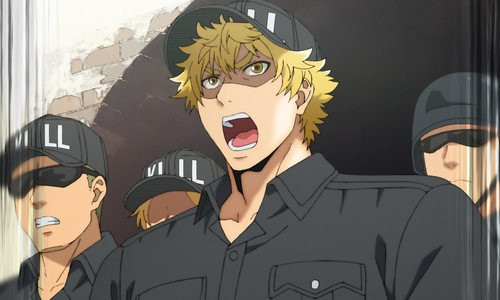 .
O desenvolvimento dos personagens é bem dinâmico, principalmente do glóbulo vermelho, já que ela é que é a verdadeira protagonista, tanto que tem um episódio focado bastante nela, mas os secundários também são desenvolvidos e você entende como cada um chegou na função que exerce no tempo presente da história, ou seja nada a reclamar nesse quesito.
Além disso a trilha é comum não tendo grande destaque na série, mesmo a sua abertura não é lá tão boa(mesmo que o vídeo seja bem legal de se ver), ainda assim devo dar destaque para os dois últimos episódios que foram os melhores em todos os aspectos do anime.
1. Episódio 11 e 12
Esses episódios, na minha opinião, foram os melhores porque teve três coisas que ele queria repassar o desenvolvimento duplo do glóbulo vermelho e uma sensação de urgência quando algo está MUITO errado no corpo.
O desenvolvimento duplo se deve ao fato que a protagonista teve que ensinar uma novata, ou seja ela tinha que mostrar que era capaz de ensinar alguém mais novo que acabou de iniciar o seu trabalho, enquanto trabalhava o que era difícil já que as personalidades e os jeitos das duas eram completamente opostos, e paralelo a isso acontecia um choque hemorrágico ( é algo MUITO MUITO GRAVE) e ao longo dos episódios a gente vê ela se desenvolvendo se provando capaz e mostrando pra sua kouhai que mesmo que você seja sério ou atrapalhado você deve fazer o seu serviço como todo o amor e cuidado porque todos dependem de todos no corpo humano.
__ANIMAÇÃO 10/10
ENREDO 7/10
TRILHA 8/10
DESENVOLVIMENTO 9/10
__
Por fim o trabalho do diretor Kenichi Suzuki que trouxe uma obra divertida, educativa e pouco enjoativa, mal posso esperar pela segunda temporada, no geral o anime é muito bom e recomendável para todos que quiserem aprender ou ensinar biologia.
Obrigado a todos que leram esse review e até a próxima.
~~~~~~~~~~~~
.
O desenvolvimento dos personagens é bem dinâmico, principalmente do glóbulo vermelho, já que ela é que é a verdadeira protagonista, tanto que tem um episódio focado bastante nela, mas os secundários também são desenvolvidos e você entende como cada um chegou na função que exerce no tempo presente da história, ou seja nada a reclamar nesse quesito.
Além disso a trilha é comum não tendo grande destaque na série, mesmo a sua abertura não é lá tão boa(mesmo que o vídeo seja bem legal de se ver), ainda assim devo dar destaque para os dois últimos episódios que foram os melhores em todos os aspectos do anime.
1. Episódio 11 e 12
Esses episódios, na minha opinião, foram os melhores porque teve três coisas que ele queria repassar o desenvolvimento duplo do glóbulo vermelho e uma sensação de urgência quando algo está MUITO errado no corpo.
O desenvolvimento duplo se deve ao fato que a protagonista teve que ensinar uma novata, ou seja ela tinha que mostrar que era capaz de ensinar alguém mais novo que acabou de iniciar o seu trabalho, enquanto trabalhava o que era difícil já que as personalidades e os jeitos das duas eram completamente opostos, e paralelo a isso acontecia um choque hemorrágico ( é algo MUITO MUITO GRAVE) e ao longo dos episódios a gente vê ela se desenvolvendo se provando capaz e mostrando pra sua kouhai que mesmo que você seja sério ou atrapalhado você deve fazer o seu serviço como todo o amor e cuidado porque todos dependem de todos no corpo humano.
__ANIMAÇÃO 10/10
ENREDO 7/10
TRILHA 8/10
DESENVOLVIMENTO 9/10
__
Por fim o trabalho do diretor Kenichi Suzuki que trouxe uma obra divertida, educativa e pouco enjoativa, mal posso esperar pela segunda temporada, no geral o anime é muito bom e recomendável para todos que quiserem aprender ou ensinar biologia.
Obrigado a todos que leram esse review e até a próxima.
~~~~~~~~~~~~
SIMILAR ANIMES YOU MAY LIKE
 ANIME AdventureSeimei no Kagaku: Micro Patrol
ANIME AdventureSeimei no Kagaku: Micro Patrol ANIME ComedyMoyashimon
ANIME ComedyMoyashimon ONA ComedyHetalia Axis Powers
ONA ComedyHetalia Axis Powers ANIME ComedyTenchi Souzou Design-bu
ANIME ComedyTenchi Souzou Design-bu MOVIE ActionJintai no Survival!
MOVIE ActionJintai no Survival! ANIME ActionDr. STONE: STONE WARS
ANIME ActionDr. STONE: STONE WARS
SCORE
- (3.65/5)
TRAILER
MORE INFO
Ended inSeptember 30, 2018
Main Studio David Production
Trending Level 2
Favorited by 2,316 Users
Hashtag #はたらく細胞













